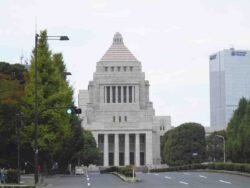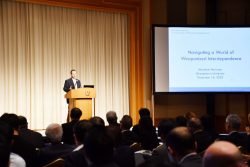Central Japan City to Help Foreign Students Cope by Facilitating Online Classes from Their Home Countries

A foreign student takes an online arithmetic class taught by an instructor in his home country at a special classroom set up by an NPO in Kikugawa, Shizuoka Prefecture.
12:31 JST, August 28, 2024
KAKEGAWA, Shizuoka — When the city of Kakegawa found that foreign children were struggling in school due to insufficient Japanese language skills and a lack of staff to help them, it came up with a novel idea to help them keep up with their studies.
The Shizuoka Prefecture city decided to held facilitate on-line learning for the students through cooperation with educational institutions in their home countries, allowing them to be taught in their native language.
The number of students requiring Japanese language instruction is increasing, but it has been difficult to find support staff who are able to handle the various different languages. Kakegawa sees the new program as an effective way to address the problem.
According to the city’s Board of Education, the introduction of such a program in schools is a rarity in Japan.
Trial implementation at 4 schools
Four of the city’s 22 elementary schools will begin trials of the program in arithmetic in the second semester. The schools will tell the overseas school what content they would like to be taught and classes will be formulated accordingly.
The Philippines’ Tagalog will be among the first languages tested, and if the program proves effective, it will be expanded to other languages and subjects in moving toward full implementation.
According to the Board of Education, 386 of the 9,454 students in its elementary and junior high schools, or about 4%, were non-Japanese as of May 1. They come from about 10 countries, mainly Brazil, the Philippines, Vietnam, China, Sri Lanka and Uzbekistan.
Although there are eight staff members assigned to assist foreign students at the city’s 31 elementary and junior high schools, nearly half of the students have special needs, such as needing help with school subjects or Japanese language instruction.
The city said that it is difficult to find staff for each language in Japan due to the costs and the lack of human resources. It plans to provide support until the students have become sufficiently proficient in Japanese and can follow along in classes at school.
Teachers at local cram schools
In preparation for the enrollment of foreign students in public elementary and junior high schools, the three cities of Kakegawa, Kikugawa, and Omaezaki subcontracted Japanese language and arithmetic/math classes to a special Kikugawa-based classroom operated by an NPO called the “Shizuoka Prefecture Education Forum.”
The classroom formed an alliance with “e-Education,” a non-profit organization that provides IT-based educational support to children in Asia. Together, the organizations arranged for students to learn arithmetic online from local cram school instructors back home starting in mid-May.
Three children, two from the Philippines and one from Nepal, currently receive lessons in their native language once or twice a week.
The program that Kakegawa is developing will also be implemented with the cooperation of e-Education.
Increased demand for Japanese
The Education, Culture, Sports, Science and Technology Ministry found that in the 2023 academic year there were 57,718 foreign students enrolled in public elementary, junior high, and high schools in need of Japanese-language instruction — an increase of about 10,000 from a similar survey in the 2021 academic year.
The number of such students in Shizuoka Prefecture increased by 492 to 4,275.
“I am sure that the new program will enable us to provide more attentive guidance than before,” said Yoshiaki Sato, the city’s superintendent of education. “I think this will serve as a model for the rest of the country.”
Kikugawa, which has the highest percentage of foreign residents in the prefecture at about 8.5%, is also considering a trial program for arithmetic classes in elementary school .
"Society" POPULAR ARTICLE
-

M4.9 Earthquake Hits Tokyo, Neighboring Prefectures
-

M7.5 Earthquake Hits Northern Japan; Tsunami Waves Observed in Hokkaido, Aomori and Iwate Prefectures
-

Tsukiji Market Urges Tourists to Avoid Visiting in Year-End
-

Beloved Cat Stationmaster Nitama in Wakayama Pref. Passes Away at 15
-

M5.7 Earthquake Hits Japan’s Kumamoto Pref., Measuring Upper 5 Intensity, No Tsunami Expected
JN ACCESS RANKING
-

Japan’s Hopes for Seafood Exports Shot Down in China Spat
-

Keidanren Chairman Yoshinobu Tsutsui Visits Kashiwazaki-Kariwa Nuclear Power Plant; Inspects New Emergency Safety System
-

Japan to Charge Foreigners More for Residence Permits, Looking to Align with Western Countries
-

Japan Exports Rise in October as Slump in U.S. Sales Eases
-

Govt Aims to Expand NISA Program Lineup, Abolish Age Restriction
























